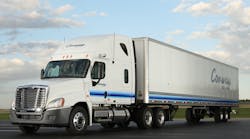Saul Gonzalez will tell you that driver retention is one of the most important issues facing the truckload industry right now – affecting everything from equipment choice, pay and benefits, even the type of freight carriers choose to haul. And it’s an issue that will affect the industry long term, he stressed.
“Frequent turnover used to be accepted among truckload carriers as simply the nature of the business; we’d just keep recruiting to fill those empty seats,” Gonzalez, COO for Con-way Truckload, explained during a sit down interview with Fleet Owner at the carrier’s Joplin, MO, headquarters.
“But now that’s changed; older truck drivers are retiring and not many kids want to be truck drivers,” he added. “So now we really have to look at retention and all sorts of things we used to take for granted: length of haul, driver-friendly freight, equipment, onboard technology, home time. It’s a big puzzle we have to sort out and put back together.”
One of the interesting twists Con-way Truckload discovered in its retention efforts is that many new hires are choosing truck driving as a “second career” of sorts.
“There’s a certain percentage of people we’re finding that no matter what they went to school for – engineering, medicine, law enforcement – they didn’t like that chosen career,” Gonzalez said. “We’re now getting drivers from all walks of life today. For that reason alone, we’ve got to make the driving jobs we offer easier and more attractive than the careers they are dissatisfied with.”
He added that bringing on such “newbies” also has an added benefit in that there are no “bad driving habits’ that need breaking. “By training them ourselves, we set them up to drive the way we need them to drive,” Gonzalez explained.
For example, Con-way Truckload is 100% with EOBRs or electronic onboard recorders now – devices known as “black boxes” that automatically record drive on- and off-duty data – and that may be easier for a new driver to adjust to than a veteran long used to using paper logbooks.
Shippers and receivers are playing a bigger role in the complex math of driver retention as well, Gonzalez stressed, as their freight practices are finally gaining long-overdue recognition for their impact not only on driver retention but regulatory compliance and highway safety as well.
“We don’t want to charge detention time for excessive delays – we want maximum equipment efficiency. We’d rather not have those delays to start with,” he said.
“Pickup and delivery times plus driver dwell time all affect the outcome as to whether we satisfy a driver’s home time needs as well as stay compliant with hours of service rules,” Gonzalez stressed. “That’s why we’re relying more and more on technology now to figure this all out; to satisfy the driver and the customer simultaneously, we need to become far more efficient as to how we move freight.”



